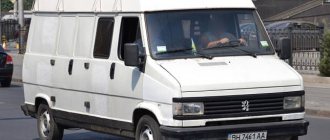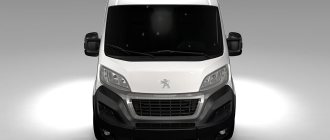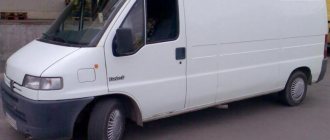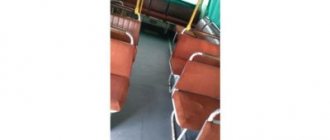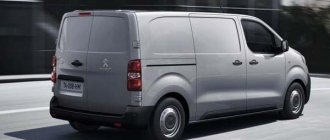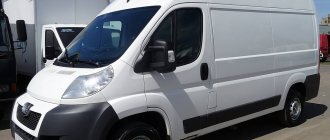Peugeot Boxer Tour Transformer
Peugeot Boxer Tour Transformer
Peugeot Boxer Tour Transformer
Most companies outsource the production of special cars to third-party body shops - it’s easier, and most importantly, cheaper to adapt to the requirements of the local market. Based on the well-known Peugeot Boxer in Russia, the Nizhny Novgorod company managed to build a car that combines the advantages of five different cars.
Turning a truck into a minibus is a well-known path, but only at Riviera they thought about how to maintain cargo capabilities without sacrificing comfort and, if you like, business content.
Interpretation of the Peugeot Boxer FV 330 L2H1 2.2 HDI 100 model markings
To distinguish models, the manufacturer uses special letter markings:
- FV – body type designation: FT – all-metal van; ChC – chassis; Comby – cargo-passenger (in this case a glazed van is presented);
- 330 – total weight of the car – 3000 kg (333 – 3300 kg; 335 – 3500 kg; 440 – 4400 kg);
- L – length of the cargo part of the vehicle (L1 – 2.67 m; L2 – 3.12 m; L3 – 3.705 m; L4 – 4.07 m);
- H – maximum permissible load height (H1 – 1.662 m; H2 – 1.932 m; H3 – 2.172 m);
- 2 HDI 100 – capacity, type and power of the engine (in this case presented: turbodiesel – type; 2.2 l. – capacity; 100 hp. – power).
MANUFACTURER DATA
The Peugeot Boxer Tour Transformer, the first sign, is painted in a golden metallic, unusual for this type of car, including bumpers and rear-view mirrors. External signs immediately indicate that this is a difficult car in front of me. Although, at first glance, nothing special. It is unlikely that anyone will be surprised by the special rails in the floor on which a pair of folding sofas ride. But they are covered with real (!) leather.
Advantages and disadvantages of the model
If we compare Peugeot Boxer cars with competing brands of trucks with similar characteristics, this model is better in terms of price and quality.
Peugeot Boxer salons are more comfortable and roomy than those of competitors, this is due to the leaders of the French automobile industry, since they really give preference to ergonomic indicators. The model is equipped only with advanced equipment and a powerful traction motor, which is capable of accelerating even a loaded vehicle to maximum speed in a short time with low fuel consumption.
But the Peugeot Boxer model also has disadvantages that are associated with the adaptation of a European car to domestic roads, temperatures and quality of maintenance. Particularly problematic components of the Peugeot Boxer in Russian operating conditions are steering ends, electronics and ball joints. The car takes a long time to warm up in winter, but the interior still remains cold.
Luxurious sofas are covered with real leather. This is very rare for a car of this class.
Luxurious sofas are covered with real leather.
This is very rare for a car of this class. Luxurious sofas are covered with real leather. This is very rare for a car of this class.
They can be arranged both in a coupe version and in the traditional order for minibuses. The sides, floor and roof have additional heat and sound insulation. Naturally, all side windows are tinted: this is the norm for us.
If the seats in the passenger compartment are folded down, you get a large bed for an overnight stay. By folding the sofas and moving them closer to each other, we will free up space for a wide variety of cargo; fortunately, the width of the body and the rear hinged doors allow you to cram a lot of stuff into the Boxer.
The seats can be removed altogether, but it is better to remove them with a partner. However, this method of transformation is familiar to many commercial vehicles.
description, characteristics, reviews, prices, photos. owner reviews
Peugeot Boxer: description, characteristics, reviews, prices, photos.
Peugeot Boxer / Peugeot Boxer is what you need. Whatever your professional needs, Boxer will always get the job done - day after day, week after week, year after year. A reliable car, well proportioned, easy to maintain, pleasant to drive and easy to load.
The Peugeot Boxer Combi is a reliable, durable, unpretentious and comfortable cargo-passenger van. The body of the Peugeot Boxer Combi is made of 1.8 mm thick steel sheets, which provides it with additional durability in road collisions. The use of steel frames in the Peugeot Boxer Combi chassis creates the necessary structural rigidity. The body of the Peugeot Boxer Combi does not allow dirt to accumulate in inaccessible places, thereby reducing the likelihood of corrosion.
The steel elements of the minivan body are double galvanized and covered with five layers of protective material. Two mirror glasses in the rear-view mirrors, one of which has an aspherical surface, help reduce the blind spot of visibility. The overtaking sensor warns the Peugeot Boxer Combi driver about a pursuing vehicle that is in the blind spot, thereby stopping the driver from overtaking at the wrong time.
History of Peugeot Boxer (Peugeot Boxer)
The extensive Boxer family has been produced at the SEVEL plant in northern Italy since 1994.
The main technical features of these cars include a front transverse location of the power unit, a frame-supporting base, a front independent wishbone-spring suspension and all variants are equipped with a 5-speed manual gearbox.
In 2002, the model was restyled. Most of the exterior panels, including the doors, remained the same, but there was a new radiator grille, hood, front fenders, and bumpers. The block headlights not only increased in size, but also received shades without a pattern. The profiles of Boxer cars are easily recognizable by the wide protective plastic trim running along the entire side at the level of the wheels, and the new door handles. At the rear, rounded bumpers, lights with integrated interior ventilation holes and new “nameplates” with the name of the brand and model attract attention.
The new Boxer is the result of developments by top-level professionals who have set themselves the goal of bringing everything to perfection, down to the smallest details of the car, and introducing novelty into design solutions that have been established for years. The Boxer has powerful and economical power units, a full set of safety equipment, and advanced and ergonomic interior equipment.
The cars are equipped with one 2-liter gasoline engine producing 109 hp. and two swirl-chamber diesel engines with a working volume of 1905 and 2446 cm³. Since 2000, a new 4-cylinder 2.8-liter 2.8HDi diesel engine with a power of 128 hp has appeared on the heavier versions of the Boxer series with a gross weight of 3.2–3.5 tons.
This power unit is equipped with turbocharging, intercooling and direct fuel injection of the Common Rail system. A new 5-speed gearbox has been developed specifically to work with it.
The design of the Peugeot Boxer is a kind of revolution in the world of utility vans. A modern, versatile, comfortable car for any life situation. About 50 modifications are produced. Three wheelbases. Three bodies with a carrying capacity from 2.7 to 3.5 tons. Five bodies with a volume of up to 12 m³.
Peugeot Boxer variants: light cargo vans, utility vehicles with removable seats, passenger minibuses, flatbed trucks with single and double row cabs.
The car is used as an ambulance or public transport. No other van combines such flexibility with such high levels of comfort and a wide range of standard equipment.
An elongated hood with a convex middle zone and an enlarged radiator grille are characteristic features of the Peugeot Boxer. Twin front headlights with smooth lenses and complex reflector geometry provide excellent road illumination, thereby increasing driving safety.
Upgraded ergonomic door handles are convenient for opening the door with both the right and left hands, which will be appreciated by drivers holding a load in their hands.
Interior comfort is at the highest level. Adjustable seats and steering column; electric windows; central locking; gear shift lever located on the front panel; convenient location of switches - everything is thought out so that the driver does not waste extra effort when driving.
For the convenience of passengers, numerous storage containers are provided. The ventilation system ensures climatic comfort.
If desired, a telematics system can be installed to order, including a car radio, CD player, satellite navigation system (GPS), emergency call key, satellite telephone communication (GSM).
Made almost entirely from 1.8mm thick steel sheets, the Peugeot Boxer is more durable and resistant to impacts and road damage than other vans in the same class. Additional strength of the car is given by the chassis of increased rigidity, where steel frames are used.
To prevent corrosion, the Peugeot Boxer is designed to prevent dirt from accumulating in inaccessible areas of the body. In addition, more than 70 percent of the metal used is galvanized steel, the outer surfaces of which are double galvanized and coated with five layers of protective material.
Despite the fact that the Boxer is designed to transport a large amount of cargo, this does not in any way affect the quality and size of the interior. Thanks to the fact that the gearshift lever is located at the instrument panel, there is additional space in the front part of the cabin for a third passenger.
The Boxer's interior space is quite large. There's room for three items up to 3.36m long and up to 2.115m high, with most items able to be loaded through either the side doors or the rear door. The useful width of the van is 1.808 m.
When transporting people, the Peugeot Boxer can easily accommodate up to 10 passenger seats, making it an ideal vehicle for business purposes or for passenger transport at airports. Seat upholstery can be made according to the client's individual order.
The Boxer's basic equipment includes electrically heated and electrically adjustable exterior mirrors. Each exterior mirror has two mirror glasses, one of which is aspherical, thereby reducing the “dead” visibility zone.
An overtaking sensor is listed as additional equipment. It warns the driver about the pursuing car, which is in the “dead” zone, so that it does not overtake at the wrong time.
Parking assistance systems are also available as additional equipment. The rear view camera transmits an image of the area located behind the car to a five-inch screen. Ultrasonic sensors integrated into the rear bumper: when an obstacle is detected, the driver hears an audible signal, the frequency of which continuously increases as they approach the obstacle.
In the Boxer Combi, the seats in the second and third rows turn into comfortable tables. There is a niche for documents and a laptop, as well as a 12 V socket.
The Boxer range has a combined indexation of models, where three-digit numbers 270, 310, 320 and 350 indicate the total weight of the car in tens of kilograms. In a number of countries, indices 1000, 1400 and 1800 are used, indicating their rounded load capacity. The letters C, M, L and LL determine the size of the wheelbase - 2850, 3200, 3700 and 4050 mm, respectively. Additional letters S, H and HS indicate different levels of the roof of a van or utility vehicle.
The design of the front suspension and power steering mechanisms provide ease of driving and precise maneuvering.
Anti-lock braking system ABS is included as standard equipment, traction control ASR is only available on request for some model variants.
Today Boxer is one of the market leaders in multi-purpose minibuses. Economical, unpretentious and powerful in terms of draft parameters, the car is a reliable assistant for everyday work.
Even a child can fold the sofa into a stowed position, the mechanism works so clearly.
Even a child can fold the sofa into a stowed position, the mechanism works so clearly.
Even a child can fold the sofa into a stowed position, the mechanism works so clearly.
The highlight of this car is the intermediate, cargo-passenger version. Here, a blind partition is installed close to the sofa for passengers, which can be moved along the rails laid for the seats, changing the volume of the cargo compartment to the size of the luggage.
Its sealing solution is simple and original: an elastic roller is attached along the perimeter of the bulkhead. But the most important thing is that this magical wall is equipped with an accordion made of rubberized material in the manner of the one that is installed on articulated buses.
One side of it is firmly attached to the car body, the other is fixed to the mobile wall and reliably isolates the cargo compartment from the passenger area. I drove the car in February, when it was not hot outside, and therefore especially noted this option.
